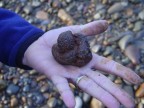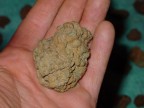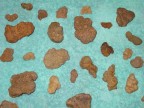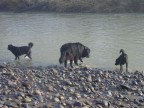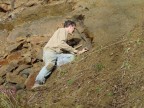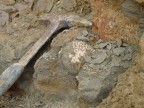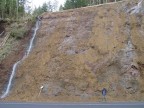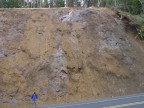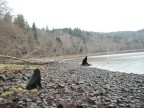Search and Rescue Report |
1/20/2007 to 1/21/2007 |
| Jerry, Andy, and I departed early Saturday morning and headed North on I-5 to collect along the banks of Salmon Creek near Toledo, WA. It's a little early in the season to be collecting creeks and rivers but other than a little snow earlier this week the Pacific NW hasn't seen much precipitation in several weeks. Because of this we didn't schedule much time for collecting this area just in case it was a bust.
I haven't spent much time researching the specimens we planned on collecting but there seems to be some disagreement on if it's coprolite (fossilized animal poop) or siderite nodules from the Miocene Wilkes Formation. Either way it seemed like a fun thing to collect and talk about. We arrived at the first stop and that creek level was pretty high but a few gravel bars were still exposed and we made our way down to one. Usually one avoids objects that look like doo so it took me some time before I found my first specimen. Yes, we had lots of poop jokes but that was part of the fun. Andy found the nicest specimen at the first location and I spent most of my time picking up agates, which littered the area. After about 45 minutes we hopped the trucks and headed up stream. The highest point on the creek that can be reached by vehicles is a bridge that crosses it on Salmon Creek Rd. Unfortunately the water was too high and we didn't see any areas up or down stream from the bridge that could be collected. It was a little disappointing because I only found one specimen so far. We tried one more road to check out and on the bridge we spotted a pretty small gravel bar that was more sand than gravel. It was our last chance to find anything so we hiked over to explore it. We really lucked out and immediately began to find some nice material and after about 30 minutes we had about 30 to 40 specimens and pockets full of agates. Satisfied with the material we found we departed and headed to the Porter area to collect in the Lincoln Creek Formation. After an hour of driving we reached out destination. I really wasn't into putting much effort into digging but I did my best. It took about 15 minutes before we found our first crab nodules and we ended up with about 10. We moved down the exposure into an are where we find the nautiloid, Aturia. I was hoping to find more microfossils and forams like I did on our last outing but I wasn't willing to work too hard for them. Andy really did well and rescued one of the largest gastropods I've ever seen from the Lincoln Creek Formation. I'm exited to see what it turns out to be once it's cleaned up and identified. Some light rain moved in so we called it a day and departed toward our final destination to set up camp for the night. The plan for Sunday was to collect along the banks of the Columbia River for both Lincoln Creek and Astoria Formation fossils. Our usual site is 25 miles away from the location and because low tide was at 7:30 am we wanted to find a closer site. All but one logging road in the area was gated and about a quarter mile up it we found an acceptable site to camp. I really shouldn't have looked over the edge by camp. It was a really disturbing to see that this site was used as a dump for Elk carcasses. There must have been 15 to 20 carcasses littering the hillside below were we planned on camping. I have no problem with hunters but they could have a little respect for the animal and not dispose of them illegally. With that we headed to KM Mountain where we usually camp. I heard about a big slide on KM earlier in the year and wanted to check it out. KM has been posted "No Trespassing" for about a year but I wanted to see it anyway. It was a great slide and exposed a huge area. I know of two areas that material is dumped from slide on KM and since it was still a little light out we checked them out. We found the site where WDOT dumped over 1000 yards of material from the slide. Most of what was removed from the slide was topsoil and we didn't have any luck finding concretions that may have found their way into the debris. Around sunset we reached camp and started to setup. I like to travel light and quick and instead of setting up a tent I like to use a large tarp. They work great and provide plenty of protection from the elements. The only problem with large tarps is they act like a large kit in the wind. I've experience this a few times and know to either pick a place that's protected from the wind or utilize every grommet and anchor it very well. The rest of the evening was spent eating and sitting around the campfire discussing our wives, Dell Computers, how our wives use computers, and other very important topics. Andy's alarm either failed to go off or we just didn't hear it and we were an hour behind schedule when we woke. One thing about trips I guide is that when it's time to go, it's time to go. Jerry and I are pretty efficient at setting up and taking down camp. When it's time to go that means you have about 30 minutes to cook breakfast, eat, break down camp, load up vehicles, and be on the road. In about 20 minutes we had two pots of coffee, a few donuts, fed the dogs, and everything loaded in the truck and were on the road. After reaching our destination we bushwhacked 300 yards to the riverbank. Even though it was a +2.5 foot low tide we had plenty of area to explore. On my visit last summer to this location the beach was covered in sand hiding the concretions. I was hoping that over fall and winter some of the sand would be removed but it wasn't any better. I ended up finding one spider crab carapace (Trichopeltarion granulose), a few chunks of teredo wood, and a shark vertebra. Maybe in a month or two the beach will be in better condition to search and I'm already planning a trip back to Salmon Creek for more poo. NARG Members: Jerry Rawdon, Andy Burkholz, Andrew Bland, and dogs Victor, Steve, Frank Reference: Enigmatic origin of ferruginous "coprolites": Evidence from the Miocene Wilkes Formation, southwestern Washington, George E. Mustoe, Geology Department, Western Washington University, Bellingham, Washington 98225, USA |
| ©2004 NARG - North America Research Group |


